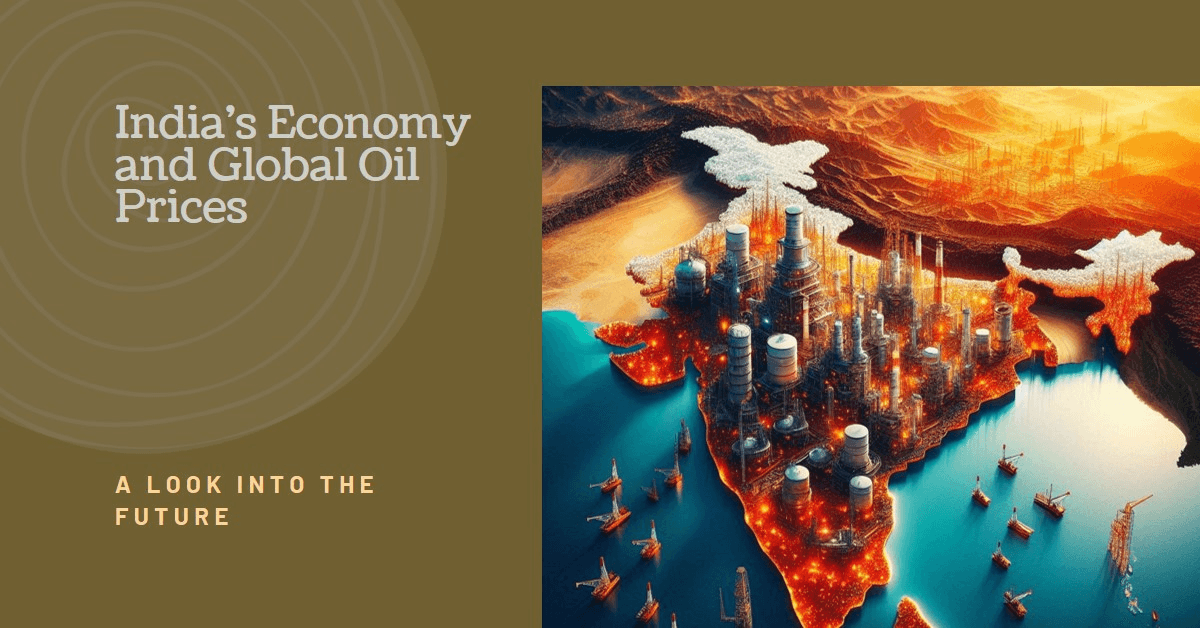Global oil prices are a critical factor shaping the economic landscape of many countries, and India, as the world’s third-largest oil consumer, is particularly sensitive to changes in the oil market. The fluctuations in global crude prices influence a wide range of sectors, from transportation and logistics to inflation and industrial growth. In 2024, the ripple effects of global oil prices on India’s economy are more pronounced than ever due to inflationary pressures, rising demand, and geopolitical tensions.
This article explores how global oil price trends impact India’s economy, focusing on key sectors like transportation, logistics, inflation, and government policies. We’ll also discuss the actionable strategies businesses and consumers can adopt to mitigate these effects. Additionally, we will provide internal links to previous articles related to inflation and economic policies, as well as external references for further reading.
The Connection Between Global Oil Prices and India’s Economy
India is highly dependent on imported crude oil, with over 85% of its oil needs being met by imports. This heavy reliance makes India vulnerable to the fluctuations in global oil prices. When prices rise, the cost of importing oil increases, leading to higher fuel prices domestically, which has a domino effect on inflation, transportation costs, and overall economic growth.
According to the Ministry of Petroleum and Natural Gas, India imported approximately 4.7 million barrels per day of crude oil in 2023. As the global oil market faces price volatility in 2024 due to geopolitical tensions in the Middle East, the Russia-Ukraine conflict, and OPEC+ production cuts, India is feeling the economic impact in several ways.
Impact on Transportation and Logistics
1. Rising Fuel Prices and Transportation Costs
The transportation sector is directly affected by fuel price increases, as vehicles running on diesel and petrol account for a large share of India’s logistics and public transportation systems. In 2024, rising global oil prices have led to higher costs for transporting goods across the country, impacting the logistics sector and consumers alike.
- Freight Costs: Diesel prices in India have risen in line with global oil price trends, leading to higher freight costs for goods transported by road. This has a cascading effect on retail prices, particularly for essential goods like food and consumer products.
- Public Transportation: Higher oil prices also increase the cost of running buses, trains, and taxis, potentially leading to fare hikes that disproportionately affect lower-income groups who rely on public transportation.
For a deeper look at how rising costs affect household expenses, see our article on inflationary pressures in India.
2. Aviation Sector Struggles
The aviation sector, which has already been recovering from the COVID-19 pandemic, faces another setback due to higher fuel costs. Aviation turbine fuel (ATF) prices are closely linked to global oil prices, and any rise directly impacts airfares. This affects not only passenger travel but also the air cargo industry, which is essential for transporting high-value goods across India and internationally.
- Airlines Adjust Fares: Many Indian airlines have already increased fares to offset the rising cost of ATF, which could dampen travel demand during festive seasons and holidays in 2024.
- Supply Chain Delays: With the higher cost of air cargo, companies may face delays in shipping products, further complicating supply chains that are already stressed due to global disruptions.
Logistics Sector: Coping with Rising Costs
The logistics industry, a critical backbone of India’s economy, is heavily impacted by fuel price fluctuations. Rising global oil prices increase the operational costs for logistics companies that rely on fuel-powered trucks, ships, and planes to transport goods.
1. Effect on E-Commerce and Retail
E-commerce, one of India’s fastest-growing sectors, is highly dependent on an efficient and affordable logistics system. Higher transportation costs lead to increased delivery charges, which could discourage online shopping and affect e-commerce companies’ profitability.
- Last-Mile Delivery Costs: Rising fuel prices have led to a significant increase in last-mile delivery costs, which e-commerce platforms may pass on to consumers. This could reduce sales volumes and hurt profit margins for smaller businesses.
2. Industry Response to Rising Fuel Prices
To manage rising fuel costs, many logistics companies are adopting strategies like:
- Optimizing routes: To reduce fuel consumption, logistics providers are using data analytics and route optimization technologies to streamline operations.
- Switching to alternative fuels: Some companies are investing in electric vehicles (EVs) or exploring the use of biofuels to reduce their dependency on fossil fuels. While this transition is gradual, it could offer long-term savings as fuel prices remain volatile.
For more on how economic trends affect different sectors, check out our article on emerging trends in renewable energy.
Inflation: The Domino Effect of Rising Oil Prices
Global oil prices play a crucial role in determining inflation levels in India, as higher fuel costs lead to increased prices for goods and services across the board. In 2024, inflation has been a significant concern for policymakers and businesses alike, with rising oil prices contributing to the surge in overall inflation rates.
1. Food and Commodity Prices
One of the most direct impacts of rising fuel prices is on food inflation. As transportation costs increase, so does the price of food products, particularly those that need to be transported over long distances, such as fresh produce. Higher oil prices also affect the cost of agricultural inputs like fertilizers and machinery, further increasing food production costs.
- Essential Commodities: Items such as grains, vegetables, and fruits have seen price hikes due to increased transportation costs. According to the Reserve Bank of India (RBI), food inflation in 2024 is expected to remain elevated, exacerbating the cost-of-living crisis for many households.
2. Impact on Consumer Goods
Besides food, the prices of consumer goods such as electronics, clothing, and appliances are also affected by rising fuel prices. Manufacturing costs increase as companies face higher transportation expenses for raw materials and finished goods. This leads to higher retail prices, reducing consumers’ purchasing power.
Expert Analysis: Economists predict that inflation in India will remain above the RBI’s comfort zone of 4% in 2024, largely due to the impact of rising oil prices. The central bank may need to adjust its monetary policies to counteract these inflationary pressures, which could affect interest rates and borrowing costs for businesses and consumers alike.
For more information on India’s inflation trends, read our detailed article on inflation and its economic impact in India.
Government Policies: Responding to Rising Oil Prices
The Indian government has been proactive in addressing the challenges posed by rising global oil prices. In 2024, several policy measures have been implemented to mitigate the economic impact of fuel price volatility.
1. Fuel Subsidies and Price Controls
To protect consumers from the full brunt of rising global oil prices, the Indian government has maintained fuel subsidies on essential products like diesel and kerosene. However, these subsidies strain public finances and may not be sustainable in the long term.
- Tax Reductions: The government has also reduced excise duties on petrol and diesel in an attempt to stabilize domestic fuel prices. While this provides some relief to consumers, it reduces the government’s tax revenue, impacting its ability to fund public welfare programs.
2. Promotion of Renewable Energy
To reduce India’s dependence on imported oil, the government has been promoting the use of renewable energy sources, such as solar, wind, and biofuels. By investing in renewable energy infrastructure, India aims to reduce its vulnerability to global oil price fluctuations in the long term.
Renewable Energy Initiatives: The government’s push for electric vehicles (EVs) and public transportation systems powered by renewable energy sources is expected to reduce the demand for fossil fuels, mitigating the economic impact of rising global oil prices.
For insights into India’s renewable energy transition, read our article on renewable energy trends in India.
Strategies for Businesses and Consumers
While rising global oil prices are largely beyond the control of businesses and consumers, there are several strategies that can be adopted to mitigate their impact.
1. For Businesses
- Diversify Energy Sources: Businesses can reduce their fuel dependency by investing in renewable energy sources, such as solar power, for their operations. Additionally, companies can explore the use of electric vehicles for logistics and transportation.
- Optimize Operations: Companies should focus on improving fuel efficiency by optimizing their supply chains and transportation routes, reducing fuel consumption and operational costs.
2. For Consumers
- Energy Efficiency: Consumers can reduce their fuel consumption by using fuel-efficient vehicles, carpooling, or using public transportation.
- Budgeting for Inflation: Households should adjust their budgets to account for rising prices of essential goods and services, ensuring they are prepared for inflationary pressures.
Conclusion: The Way Forward for India
As global oil prices continue to fluctuate in 2024, the Indian economy will face challenges in managing inflation, transportation costs, and logistics expenses. However, through strategic policy measures, the promotion of renewable energy, and the adoption of efficient business practices, India can mitigate the impact of rising oil prices on its economy.
To learn more about how India’s economy is navigating the global oil crisis, visit our article on India’s inflation trends and economic policies.
External References:
- Ministry of Petroleum and Natural Gas: Oil Imports and Prices
- Reserve Bank of India: Monetary Policy Updates
- [International Energy Agency: Global Oil Market










